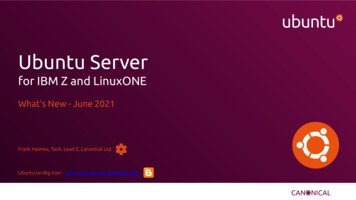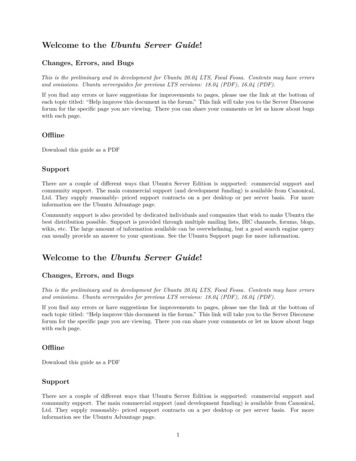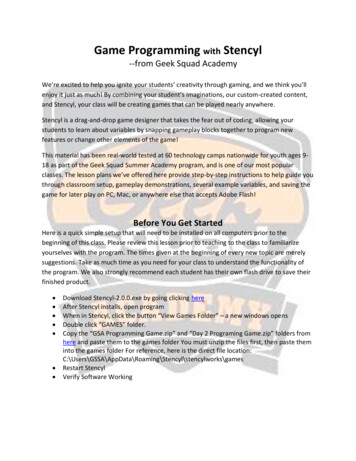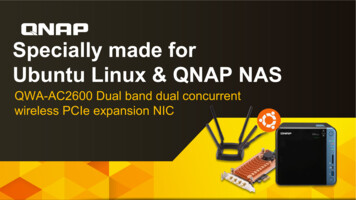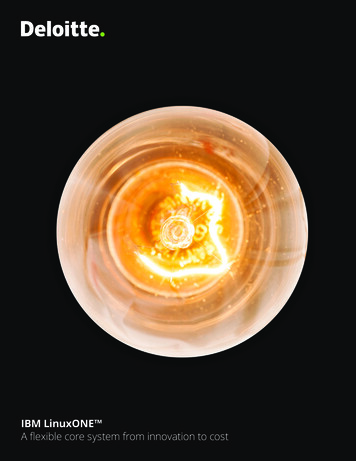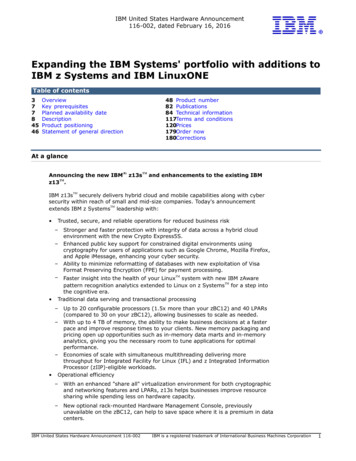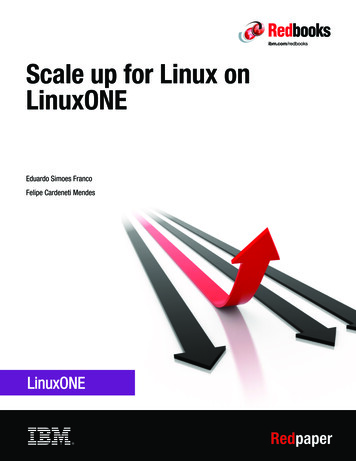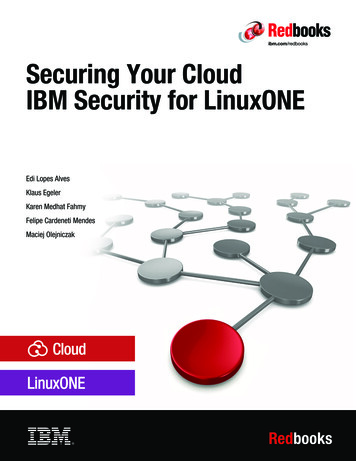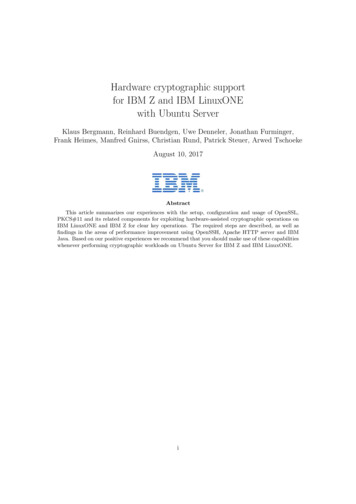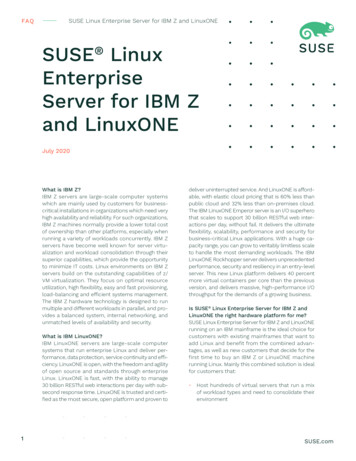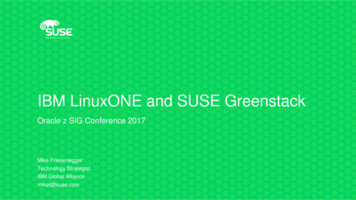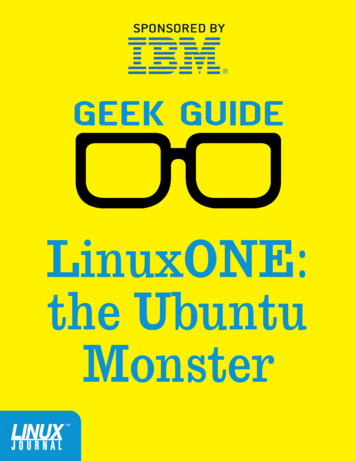
Transcription
GEEK GUIDE LinuxONE: the Ubuntu MonsterTable of ContentsAbout the Sponsor 4Introduction 5What Is LinuxONE? 8The Hardware 9The Software 11VMs on Steroids 12Comparison with x86 13Where LinuxONE Fits 16Leverage Your Existing Linux Infrastructure 17Leverage Your Existing Software 18Cluster Performance without the Cluster Overhead 20On-Premises and Hybrid Clouds 21Why You Might Use LinuxONE 22Mobile Apps 22Real-Time Analytics of Financial Data 23Getting a Taste 24Resources 25JOHN S. TONELLO is the Director of IT for NYSERNet Inc., New York state’s regionaloptical networking company. He’s been a Linux user and enthusiast since building hisfirst Slackware system from diskette 20 years ago. Since then, he’s developed Weband IT solutions for major universities, Fortune 500 companies and small start-ups.A former Cornell University IT trainer and writer, John served six years as the mayorof an Upstate New York city, where he championed the use of technology to help solveproblems facing municipalities.2
GEEK GUIDE LinuxONE: the Ubuntu MonsterGEEK GUIDES:Mission-critical information for the most technical people on the planet.Copyright Statement 2016 Linux Journal. All rights reserved.This site/publication contains materials that have been created, developedor commissioned by, and published with the permission of, Linux Journal(the “Materials”), and this site and any such Materials are protected byinternational copyright and trademark laws.THE MATERIALS ARE PROVIDED “AS IS” WITHOUT WARRANTY OF ANY KIND,EITHER EXPRESS OR IMPLIED, INCLUDING BUT NOT LIMITED TO, THE IMPLIEDWARRANTIES OF MERCHANTABILITY, FITNESS FOR A PARTICULAR PURPOSE,TITLE AND NON-INFRINGEMENT. The Materials are subject to change without noticeand do not represent a commitment on the part of Linux Journal or its Web sitesponsors. In no event shall Linux Journal or its sponsors be held liable for technicalor editorial errors or omissions contained in the Materials, including without limitation,for any direct, indirect, incidental, special, exemplary or consequential damageswhatsoever resulting from the use of any information contained in the Materials.No part of the Materials (including but not limited to the text, images, audioand/or video) may be copied, reproduced, republished, uploaded, posted,transmitted or distributed in any way, in whole or in part, except as permitted underSections 107 & 108 of the 1976 United States Copyright Act, without the expresswritten consent of the publisher. One copy may be downloaded for your personal,noncommercial use on a single computer. In connection with such use, you may notmodify or obscure any copyright or other proprietary notice.The Materials may contain trademarks, services marks and logos that are theproperty of third parties. You are not permitted to use these trademarks, servicesmarks or logos without prior written consent of such third parties.Linux Journal and the Linux Journal logo are registered in the US Patent &Trademark Office. All other product or service names are the property of theirrespective owners. If you have any questions about these terms, or if you wouldlike information about licensing materials from Linux Journal, please contact usvia e-mail at info@linuxjournal.com.3
GEEK GUIDE LinuxONE: the Ubuntu MonsterAbout the SponsorIBMIBM is a globally integrated technology and consultingcompany headquartered in Armonk, New York. Withoperations in more than 170 countries, IBM attractsand retains some of the world’s most talented people tohelp solve problems and provide an edge for businesses,governments and non-profits.Innovation is at the core of IBM’s strategy. The companydevelops and sells software and systems hardware and abroad range of infrastructure, cloud and consulting services.Hybrid Cloud is helping businesses deliver unprecedentedlevels of agility for quicker time to market and richercustomer experiences. But not all cloud infrastructures areequal. IBM z Systems and LinuxONE are the world’s leadingcloud platforms for enterprise transactions, systems ofrecord and application workloads.Today, IBM is focused on four growth initiatives—business analytics, cloud computing, growth markets andSmarter Planet. IBMers are working with customers aroundthe world to apply the company’s business consulting,technology and R&D expertise to build systems that enabledynamic and efficient organizations, better transportation,safer food, cleaner water and healthier populations.4
GEEK GUIDE LinuxONE: the Ubuntu MonsterLinuxONE:the UbuntuMonsterJOHN S. TONELLOIntroductionWhen the first Linux kernel was released 25 years ago, itbecame the go-to platform for hobbyists and developerslooking to build systems and develop software on thecheap. Since it was designed for x86 machines, the Linuxoperating system could be deployed on just about anyold hardware lying around.Of course, a lot has changed since then, and Linux has5
GEEK GUIDE LinuxONE: the Ubuntu MonsterUnlike any other mainframes in history,these machines were designed from theground up to run Linux and only Linux, andfor the first time, to run Canonical’s Ubuntualong with Red Hat and SUSE.become a viable and widely used OS for every platform,including mission-critical IT infrastructure, thanks in partto IBM’s early adoption and investment in Linux and theOpen Source community.Still, unless you’ve had the opportunity to worksomeplace that needs the mainfame-class computingpower of IBM z Systems and their predecessors, youprobably rely on cabinets filled with x86 blades outfittedwith the flavor of Linux that best suits your needs andgo on your merry way. When virtualization came along,the x86 architecture proved adaptable, and you werecontent with boosting your CPU and memory utilizationfrom 15% on bare-metal servers to 35% on virtual ones.IBM is challenging that paradigm with the launchof its new IBM LinuxONE Emperor and Rockhopper,appropriately named for two breeds of penguins. Unlikeany other mainframes in history, these machines weredesigned from the ground up to run Linux and onlyLinux and, for the first time, to run Canonical’s Ubuntualong with Red Hat and SUSE.6
GEEK GUIDE LinuxONE: the Ubuntu MonsterFIGURE 1. LinuxONE Emperor and Rockhopper (Image courtesyof IBM.)For those who’ve built their shops around clusters of x86blades and Ubuntu (which edged out Debian as the mostpopular Web server platform in May 2016), there’s now areason to take a look at alternate hardware—particularlyif data-center space is becoming limited or you’re hittinga bit of a hardware wall as you spin up and manage morethan 200 clustered VMs. Given Ubuntu’s popularity, theabundance of developers who prefer it and the massivebase of developed software available for Ubuntu, it’s prettyhard not to see real opportunity.7
GEEK GUIDE LinuxONE: the Ubuntu MonsterWhat Is LinuxONE?Launched in August 2015, IBM’s LinuxONE machinesare Linux-only z Systems that accommodate up to 10TBof memory and IBM’s industry-leading 5GHz CPUs that,depending on your needs and budget, can scale to 141cores. If you’re used to thinking in x86 blade terms, thesemachines are monsters that provide drool-worthy speeds—for both raw processing power and application deployment.The LinuxONE Emperor has 24 CPU cores dedicatedto I/O and up to 320 Power-based I/O co-processors,depending on how many cards you install. All thatpower given to I/O dwarfs x86 systems, giving theLinuxONE mind-boggling abilities to make high-speedconnections to your network and SAN, and move dataamong VMs with very low latency.IBM bills the systems as “Linux without limits”, anall-in-one platform that allows you to deploy just aboutany open-source app and service you can think of. Its realstrength is the LinuxONE’s ability to tackle huge data setsand gobble up analytics that would be more cumbersomeand costly—and slower—on traditional x86 platforms.According to IBM, LinuxONE offers an “enterprisegrade platform for Linux technology as a trustful,reliable and highly secure system to confidently deploybusiness-essential applications, optimize operating costsand achieve seamless infrastructure growth”. Whatthat means for the rest of us is that IBM has bundledtogether some of the speediest hardware—designedfor 100% uptime over decades—with some of the mostpopular and widely used open-source software to offer8
GEEK GUIDE LinuxONE: the Ubuntu Monstera system that makes sense for enterprises that may haveconsidered this hardware out of reach.The Hardware: The LinuxONE Emperor comes in fivemodels, starting with the L30, which offers 1 to 30 coresand 64GB to 2.5TB of memory. The top-end LE1 offers1 to 141 cores and up to 10TB of memory.The LinuxONE Rockhopper—what IBM calls itsentry-level system in the category—offers more modesthorsepower, yet it can be upgraded as your needs grow intofull Emperor-like capabilities. The two Rockhopper modelsoffer 1 to 10 cores (running on 4.3GHz IBM processors)with a maximum 1TB of memory for the L10 model, anda total of 20 cores and 4TB of memory for the L20.TABLE 1. IBM LinuxONE Emperor at a GlanceEmperor ModelsCores: Minimum–MaximumMemory: 0TBLE11–14164GB–10.0TBTABLE 2. IBM LinuxONE Rockhopper at a GlanceRockhopper ModelsCores: Minimum–MaximumMemory: B–4.0TB9
GEEK GUIDE LinuxONE: the Ubuntu MonsterThe capacity of these systems is, frankly, a bit jaw-dropping.For example, the LinuxONE Emperor supports 85 logicalpartitions for secure workload isolation. Partitions builtatop those partitions using the Linux-based hypervisor,KVM or IBM’s z/VM can support up to 8,000 virtualmachines and 1 million Docker containers, althoughtens of thousands are more realistic for particularapplications. Because its transactional architecture scalesquickly, the systems offer high availability with built-incomponent redundancy and “smart” features that detectproblems before they happen, along with concurrentmaintenance and repair.IBM outfitted the LinuxONE family with its z13processor that has extra microcode to optimize itsLinux performance and simultaneous multithreading,making it the fastest commercially available processoron the market.To make sure these powerful systems can connectto your SAN at speeds that don’t get in the way ofall that processing power, the LinuxONE Emperor andRockhopper offer FICON Express16S/FICON Express8S(320 ports max) that can operate at up to 8Gbps usingsingle or multimode fiber. Connecting to your networkis similarly fast with IBM’s OSA-Express5S (96 ports max)that can operate at up to 10Gbps.All that horsepower doesn’t come small, but the LinuxONEsystems won’t overwhelm your machine room. The Emperoris about four times the size of a standard 42-U cabinet. TheRockhopper has a footprint about half that. Weight varieslargely on whether you include built-in batteries.10
GEEK GUIDE LinuxONE: the Ubuntu MonsterBecause it’s built on a broad-based open-sourcephilosophy, the LinuxONE systems are a virtualplayground for Linux developers.The Software: Because it’s built on a broad-basedopen-source philosophy, the LinuxONE systems are a virtualplayground for Linux developers. Perhaps best of all, ifyou and your team have experience with open-sourcelanguages and tools, you’ll be able to use them in the IBMenvironment without skipping a beat.The system starts with a choice of hypervisors: KVMbased on SUSE, IBM’s z/VM and an Ubuntu option that’sunder development. The KVM offers an open-standardsoption that will be familiar to the growing number ofshops looking for non-proprietary hypervisor options;z/VM offers a robust platform from which to spawn bothLinux virtual machines and z/OS. You also can get thebest of both worlds: KVM and z/VM can be mixed in asingle LinuxONE system.Either choice will provide a solid foundation for managingVMs, particularly since they have baked-in support forOpenStack, the IaaS platform. Both hypervisors enable easymigration, good scalability and low-overhead performance.The LinuxONE systems introduce several popular toolsto the IBM platform, including Apache Spark, MongoDB,MariaDB, Chef and Docker.In real-world examples, Spark running on the LinuxONE11
GEEK GUIDE LinuxONE: the Ubuntu MonsterEmperor proves to be a bit of a mind-blowing tool formanaging ever-more disparate apps and data science. Asa fast, general-purpose cluster computing system, Sparkoffers a single interface for managing large data sets withR, Python, Java and Scala.Chef allows IT shops to manage servers across datacenters—even a mix of LinuxONE and x86 systems thatlive on-site and off. That means you can begin to erasethe line between private and public clouds, and managesystem resources from a central system. MariaDB, thepure open-source database created by the original makersof MySQL, is now fully supported along with MongoDBand other NoSQL databases.The combination of these tools plus the addition of Docker(and LXD) makes things really interesting. Sure, the LinuxONEcan handle 1 million containers, but what does that mean,exactly? Well, with its real-time scalability, Docker runningon LinuxONE with Spark and Spawn enables you to createclusters of micro-VMs that add Web servers, databases andany number of apps and services to your deployment asreal-time demand increases (and automatically scale backand free resources as demand wanes).The architecture pays off in speed: MariaDB, MongoDBand PostgreSQL are twice as fast on LinuxONE comparedwith x86 systems; Docker is four times faster.VMs on Steroids: Before virtualization and the onsetof commercial products, such as VMware and Hyper-V,IT shops generally followed the paradigm of one physicalmachine for each service. Need a Web server? Spin upa new blade. Need a new database? Spin up a blade.12
GEEK GUIDE LinuxONE: the Ubuntu MonsterOf course, virtualization has changed that paradigmforever, allowing enterprises of all sizes to make farbetter use of the computing power they have, tospeed up server deployments and to better preparefor disasters and business continuity.Yet, this approach has a limit to its flexibility that IBMseeks to exploit—namely the ever-increasing need tobuy and add new hardware. A single ESXi host runningVMware, for example, easily might handle 30 lightweightLinux VMs, but the next 30 will require new hardware,time for delivery and setup, and time to cluster and deploy.LinuxONE looks to make all that a thing of the past byallowing you to scale quickly with dynamically managedclustering, load-balancing, and CPU and memory allocation.The LinuxONE Emperor can host more than 8,000 VMs—aphenomenal capacity that means rapid deployment—withoutadding hardware and the clustering tasks that go with it.Comparison with x86: For those looking at one-to-onecomparisons of cost and performance between x86 andLinuxONE, there are a range of metrics to consider. Generallyspeaking, the speed and low-latency/low-overhead of theIBM cores mean that the LinuxONE is particularly good(and fast) at parallel processing. For example, a typicalJava-based Web service might consume eight cores onan x86 system, but just a single core on the z System.According to IBM’s benchmarks, the LinuxONEoutperforms x86 systems in a number of areas,particularly in Web and database transactions. Forexample, it handles 2.1 times as many Node.js Webtransactions as x86 when the systems each utilize four13
GEEK GUIDE LinuxONE: the Ubuntu Monstercores. The advantage tapers a bit as the number of coresgrows to 16 on each system, but LinuxONE maintainsa healthy advantage, serving up 5,500 transactions persecond while comparable x86 hardware handles just 3,100.FIGURE 2. With its massive I/O capabilities, LinuxONEcan handle about 1.5 times as much Node.js Web throughputas alternative systems. (Image courtesy of IBM.)14
GEEK GUIDE LinuxONE: the Ubuntu MonsterOn the database side, an independent performance testconducted by 2ndQuadrant that analyzed read-only, writeonly and in-memory workloads showed that the LinuxONEis capable of handling 1.6 to 2.2 times as many transactionsas competing hardware. A similar test with MongoDBshowed that LinuxONE could handle 1.9 to 2.1 times moreoperations than competing hardware, thanks in part to itsability to scale database transactions without sharding.CPU utilization rates also can be maintained at highlevels on the LinuxONE, because system capacity can beincreased as needed. That means if you start with a “base”FIGURE 3. PGBench results (read-only and write-only, in-memoryworkloads) on IBM LinuxONE as compared to distributed systems.LinuxONE can handle twice as many PostgreSQL transactionsper second than x86 systems. (Image courtesy of IBM.)15
GEEK GUIDE LinuxONE: the Ubuntu MonsterFIGURE 4. LinuxONE can compress and archive video, text,images, mail and other data four to seven times faster thanalternative systems. (Image courtesy of IBM.) 150,000 Rockhopper system, you can scale up and out,closely matching resources to the hardware.Where LinuxONE FitsWith OpenStack front and center, the LinuxONE systemsare poised for on- or off-premises cloud deployments andhybrid environments. That appears to be IBM’s target sweetspot, and the company argues that these systems begin tocompete well on price for shops that run 50 to 100 VMs16
GEEK GUIDE LinuxONE: the Ubuntu MonsterWhat Ubuntu developers wouldn’t want totest their apps on a monster like LinuxONE?And, what IT manager wouldn’t want to keepeverything aligned on a single, familiar OS?or more—or as few as ten physical Oracle servers. Belowthese totals, IBM admits it has trouble competing with x86solutions on price alone.However, for organizations that are quickly expandingtheir off-premises or hybrid cloud solutions—where the totalnumber of VMs is larger than many care to acknowledge—hitting the cost threshold is in reach for many.Leverage Your Existing Linux Infrastructure: But asanyone who has deployed hardware knows, deployingIT infrastructure has more to it than simply the price ofhardware, although price considerations surely have keptmany Linux developers comfortably rooted in x86 hardwareand on the mainframe sidelines.Total cost of ownership has as much to do with thehuman talent available to manage the hardware, softwareand services. If you’re an Ubuntu shop, the idea of havingeveryone learn Red Hat or SUSE may foster thoughts of costlyman hours, slowed development, lost productivity and thedread of having to deploy apps and services on a productionplatform that’s different from your development platform.By teaming up with Canonical for Ubuntu 16.04, IBM istaking that challenge head on. What Ubuntu developers17
GEEK GUIDE LinuxONE: the Ubuntu Monsterwouldn’t want to test t
The LinuxONE Rockhopper—what IBM calls its entry-level system in the category—offers more modest horsepower, yet it can be upgraded as your needs grow into full Emperor-like capabilities. The two Rockhopper models offer 1 to 10 cores (running on 4.3GHz IBM proces
